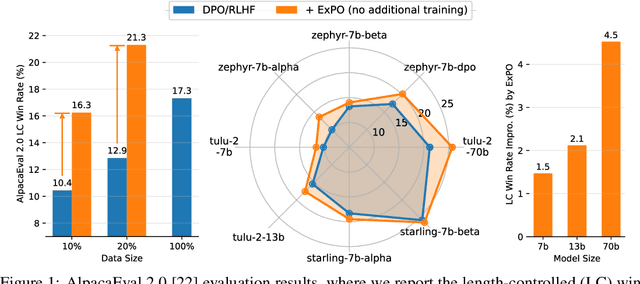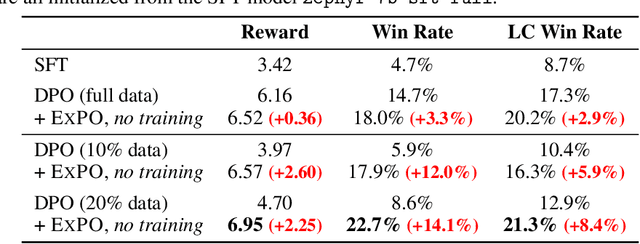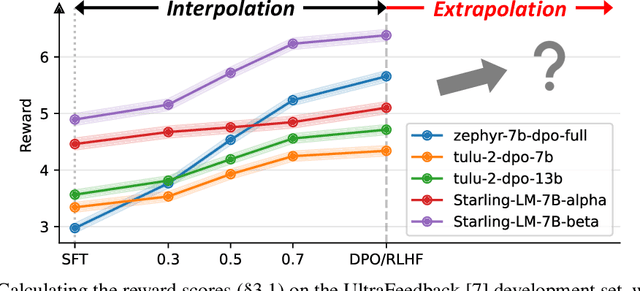Chujie Zheng
SuperGPQA: Scaling LLM Evaluation across 285 Graduate Disciplines
Feb 20, 2025Abstract:Large language models (LLMs) have demonstrated remarkable proficiency in mainstream academic disciplines such as mathematics, physics, and computer science. However, human knowledge encompasses over 200 specialized disciplines, far exceeding the scope of existing benchmarks. The capabilities of LLMs in many of these specialized fields-particularly in light industry, agriculture, and service-oriented disciplines-remain inadequately evaluated. To address this gap, we present SuperGPQA, a comprehensive benchmark that evaluates graduate-level knowledge and reasoning capabilities across 285 disciplines. Our benchmark employs a novel Human-LLM collaborative filtering mechanism to eliminate trivial or ambiguous questions through iterative refinement based on both LLM responses and expert feedback. Our experimental results reveal significant room for improvement in the performance of current state-of-the-art LLMs across diverse knowledge domains (e.g., the reasoning-focused model DeepSeek-R1 achieved the highest accuracy of 61.82% on SuperGPQA), highlighting the considerable gap between current model capabilities and artificial general intelligence. Additionally, we present comprehensive insights from our management of a large-scale annotation process, involving over 80 expert annotators and an interactive Human-LLM collaborative system, offering valuable methodological guidance for future research initiatives of comparable scope.
Aligning Instruction Tuning with Pre-training
Jan 16, 2025



Abstract:Instruction tuning enhances large language models (LLMs) to follow human instructions across diverse tasks, relying on high-quality datasets to guide behavior. However, these datasets, whether manually curated or synthetically generated, are often narrowly focused and misaligned with the broad distributions captured during pre-training, limiting LLM generalization and effective use of pre-trained knowledge. We propose *Aligning Instruction Tuning with Pre-training* (AITP), a method that bridges this gap by identifying coverage shortfalls in instruction-tuning datasets and rewriting underrepresented pre-training data into high-quality instruction-response pairs. This approach enriches dataset diversity while preserving task-specific objectives. Evaluations on three fully open LLMs across eight benchmarks demonstrate consistent performance improvements with AITP. Ablations highlight the benefits of adaptive data selection, controlled rewriting, and balanced integration, emphasizing the importance of aligning instruction tuning with pre-training distributions to unlock the full potential of LLMs.
The Lessons of Developing Process Reward Models in Mathematical Reasoning
Jan 13, 2025



Abstract:Process Reward Models (PRMs) emerge as a promising approach for process supervision in mathematical reasoning of Large Language Models (LLMs), which aim to identify and mitigate intermediate errors in the reasoning processes. However, the development of effective PRMs faces significant challenges, particularly in data annotation and evaluation methodologies. In this paper, through extensive experiments, we demonstrate that commonly used Monte Carlo (MC) estimation-based data synthesis for PRMs typically yields inferior performance and generalization compared to LLM-as-a-judge and human annotation methods. MC estimation relies on completion models to evaluate current-step correctness, leading to inaccurate step verification. Furthermore, we identify potential biases in conventional Best-of-N (BoN) evaluation strategies for PRMs: (1) The unreliable policy models generate responses with correct answers but flawed processes, leading to a misalignment between the evaluation criteria of BoN and the PRM objectives of process verification. (2) The tolerance of PRMs of such responses leads to inflated BoN scores. (3) Existing PRMs have a significant proportion of minimum scores concentrated on the final answer steps, revealing the shift from process to outcome-based assessment in BoN Optimized PRMs. To address these challenges, we develop a consensus filtering mechanism that effectively integrates MC estimation with LLM-as-a-judge and advocates a more comprehensive evaluation framework that combines response-level and step-level metrics. Based on the mechanisms, we significantly improve both model performance and data efficiency in the BoN evaluation and the step-wise error identification task. Finally, we release a new state-of-the-art PRM that outperforms existing open-source alternatives and provides practical guidelines for future research in building process supervision models.
ProcessBench: Identifying Process Errors in Mathematical Reasoning
Dec 10, 2024



Abstract:As language models regularly make mistakes when solving math problems, automated identification of errors in the reasoning process becomes increasingly significant for their scalable oversight. In this paper, we introduce ProcessBench for measuring the ability to identify erroneous steps in mathematical reasoning. It consists of 3,400 test cases, primarily focused on competition- and Olympiad-level math problems. Each test case contains a step-by-step solution with error location annotated by human experts. Models are required to identify the earliest step that contains an error, or conclude that all steps are correct. We conduct extensive evaluation on ProcessBench, involving two types of models: process reward models (PRMs) and critic models, where for the latter we prompt general language models to critique each solution step by step. We draw two main observations: (1) Existing PRMs typically fail to generalize to more challenging math problems beyond GSM8K and MATH. They underperform both critic models (i.e., prompted general language models) and our own trained PRM that is straightforwardly fine-tuned on the PRM800K dataset. (2) The best open-source model, QwQ-32B-Preview, has demonstrated the critique capability competitive with the proprietary model GPT-4o, despite that it still lags behind the reasoning-specialized o1-mini. We hope ProcessBench can foster future research in reasoning process assessment, paving the way toward scalable oversight of language models.
Yi-Lightning Technical Report
Dec 03, 2024



Abstract:This technical report presents Yi-Lightning, our latest flagship large language model (LLM). It achieves exceptional performance, ranking 6th overall on Chatbot Arena, with particularly strong results (2nd to 4th place) in specialized categories including Chinese, Math, Coding, and Hard Prompts. Yi-Lightning leverages an enhanced Mixture-of-Experts (MoE) architecture, featuring advanced expert segmentation and routing mechanisms coupled with optimized KV-caching techniques. Our development process encompasses comprehensive pre-training, supervised fine-tuning (SFT), and reinforcement learning from human feedback (RLHF), where we devise deliberate strategies for multi-stage training, synthetic data construction, and reward modeling. Furthermore, we implement RAISE (Responsible AI Safety Engine), a four-component framework to address safety issues across pre-training, post-training, and serving phases. Empowered by our scalable super-computing infrastructure, all these innovations substantially reduce training, deployment and inference costs while maintaining high-performance standards. With further evaluations on public academic benchmarks, Yi-Lightning demonstrates competitive performance against top-tier LLMs, while we observe a notable disparity between traditional, static benchmark results and real-world, dynamic human preferences. This observation prompts a critical reassessment of conventional benchmarks' utility in guiding the development of more intelligent and powerful AI systems for practical applications. Yi-Lightning is now available through our developer platform at https://platform.lingyiwanwu.com.
Semantic Search Evaluation
Oct 28, 2024



Abstract:We propose a novel method for evaluating the performance of a content search system that measures the semantic match between a query and the results returned by the search system. We introduce a metric called "on-topic rate" to measure the percentage of results that are relevant to the query. To achieve this, we design a pipeline that defines a golden query set, retrieves the top K results for each query, and sends calls to GPT 3.5 with formulated prompts. Our semantic evaluation pipeline helps identify common failure patterns and goals against the metric for relevance improvements.
Safe Unlearning: A Surprisingly Effective and Generalizable Solution to Defend Against Jailbreak Attacks
Jul 03, 2024



Abstract:LLMs are known to be vulnerable to jailbreak attacks, even after safety alignment. An important observation is that, while different types of jailbreak attacks can generate significantly different queries, they mostly result in similar responses that are rooted in the same harmful knowledge (e.g., detailed steps to make a bomb). Therefore, we conjecture that directly unlearn the harmful knowledge in the LLM can be a more effective way to defend against jailbreak attacks than the mainstream supervised fine-tuning (SFT) based approaches. Our extensive experiments confirmed our insight and suggested surprising generalizability of our unlearning-based approach: using only 20 raw harmful questions \emph{without} any jailbreak prompt during training, our solution reduced the Attack Success Rate (ASR) in Vicuna-7B on \emph{out-of-distribution} (OOD) harmful questions wrapped with various complex jailbreak prompts from 82.6\% to 7.7\%. This significantly outperforms Llama2-7B-Chat, which is fine-tuned on about 0.1M safety alignment samples but still has an ASR of 21.9\% even under the help of an additional safety system prompt. Further analysis reveals that the generalization ability of our solution stems from the intrinsic relatedness among harmful responses across harmful questions (e.g., response patterns, shared steps and actions, and similarity among their learned representations in the LLM). Our code is available at \url{https://github.com/thu-coai/SafeUnlearning}.
Weak-to-Strong Extrapolation Expedites Alignment
Apr 25, 2024



Abstract:Although the capabilities of large language models (LLMs) ideally scale up with increasing data and compute, they are inevitably constrained by limited resources in reality. Suppose we have a moderately trained LLM (e.g., trained to align with human preference) in hand, can we further exploit its potential and cheaply acquire a stronger model? In this paper, we propose a simple method called ExPO to boost LLMs' alignment with human preference. ExPO assumes that a medium-aligned model can be interpolated between a less-aligned (weaker) model, e.g., the initial SFT model, and a better-aligned (stronger) one, thereby directly obtaining this stronger model by extrapolating from the weights of the former two relatively weaker models. On the AlpacaEval 2.0 benchmark, we show that ExPO pushes models trained with less preference data (e.g., 10% or 20%) to reach and even surpass the fully-trained one, without any additional training. Furthermore, ExPO also significantly improves off-the-shelf DPO/RLHF models and exhibits decent scalability across model sizes from 7B to 70B. Our work demonstrates the efficacy of model extrapolation in exploiting LLMs' capabilities, suggesting a promising direction that deserves future exploration.
Prompt-Driven LLM Safeguarding via Directed Representation Optimization
Jan 31, 2024



Abstract:Prepending model inputs with safety prompts is a common practice of safeguarding large language models (LLMs) from complying with queries that contain harmful intents. However, the working mechanisms of safety prompts have not yet been fully understood, which hinders the potential for automatically optimizing them for improved LLM safety. Motivated by this problem, we investigate the impact of safety prompts from the perspective of model representations. We find that in models' representation space, harmful and harmless queries can be largely distinguished, but this is not noticeably enhanced by safety prompts. Instead, the queries' representations are moved by different safety prompts in similar directions, where models become more prone to refusal (i.e., refusing to provide assistance) even when the queries are harmless. Inspired by these findings, we propose a method called DRO (Directed Representation Optimization) for automatic safety prompt optimization. DRO treats safety prompts as continuous, trainable embeddings and learns to move the representations of harmful/harmless queries along/opposite the direction in which the model's refusal probability increases. We demonstrate that DRO remarkably improves the safeguarding performance of human-crafted safety prompts and outperforms strong baselines, as evaluated on out-of-domain benchmarks, without compromising the general model capability.
On Large Language Models' Selection Bias in Multi-Choice Questions
Sep 08, 2023



Abstract:Multi-choice questions (MCQs) serve as a common yet important task format in the research of large language models (LLMs). Our work shows that LLMs exhibit an inherent "selection bias" in MCQs, which refers to LLMs' preferences to select options located at specific positions (like "Option C"). This bias is prevalent across various LLMs, making their performance vulnerable to option position changes in MCQs. We identify that one primary cause resulting in selection bias is option numbering, i.e., the ID symbols A/B/C/D associated with the options. To mitigate selection bias, we propose a new method called PriDe. PriDe first decomposes the observed model prediction distribution into an intrinsic prediction over option contents and a prior distribution over option IDs. It then estimates the prior by permutating option contents on a small number of test samples, which is used to debias the subsequent test samples. We demonstrate that, as a label-free, inference-time method, PriDe achieves a more effective and computation-efficient debiasing than strong baselines. We further show that the priors estimated by PriDe generalize well across different domains, highlighting its practical potential in broader scenarios.
 Add to Chrome
Add to Chrome Add to Firefox
Add to Firefox Add to Edge
Add to Edge